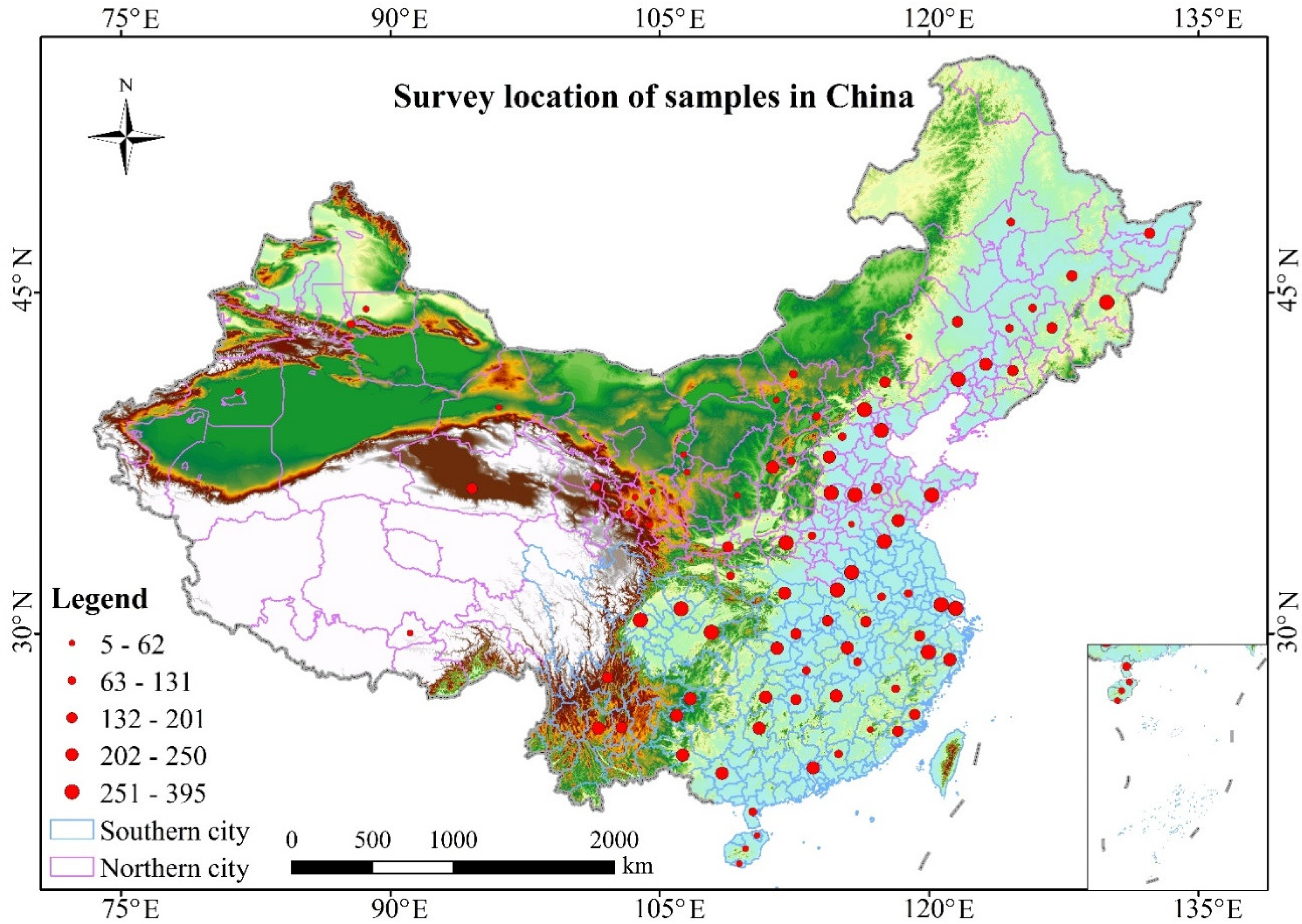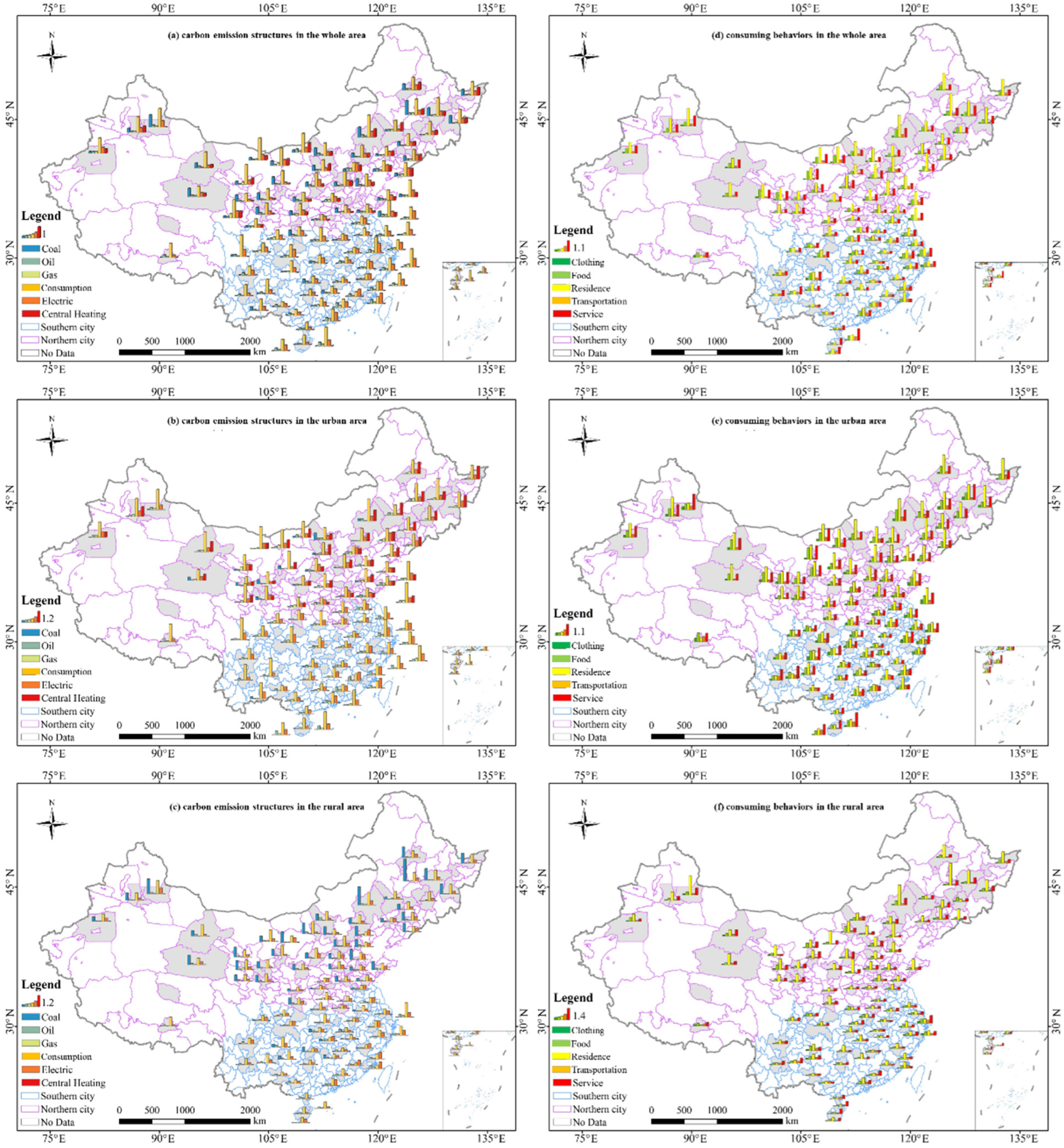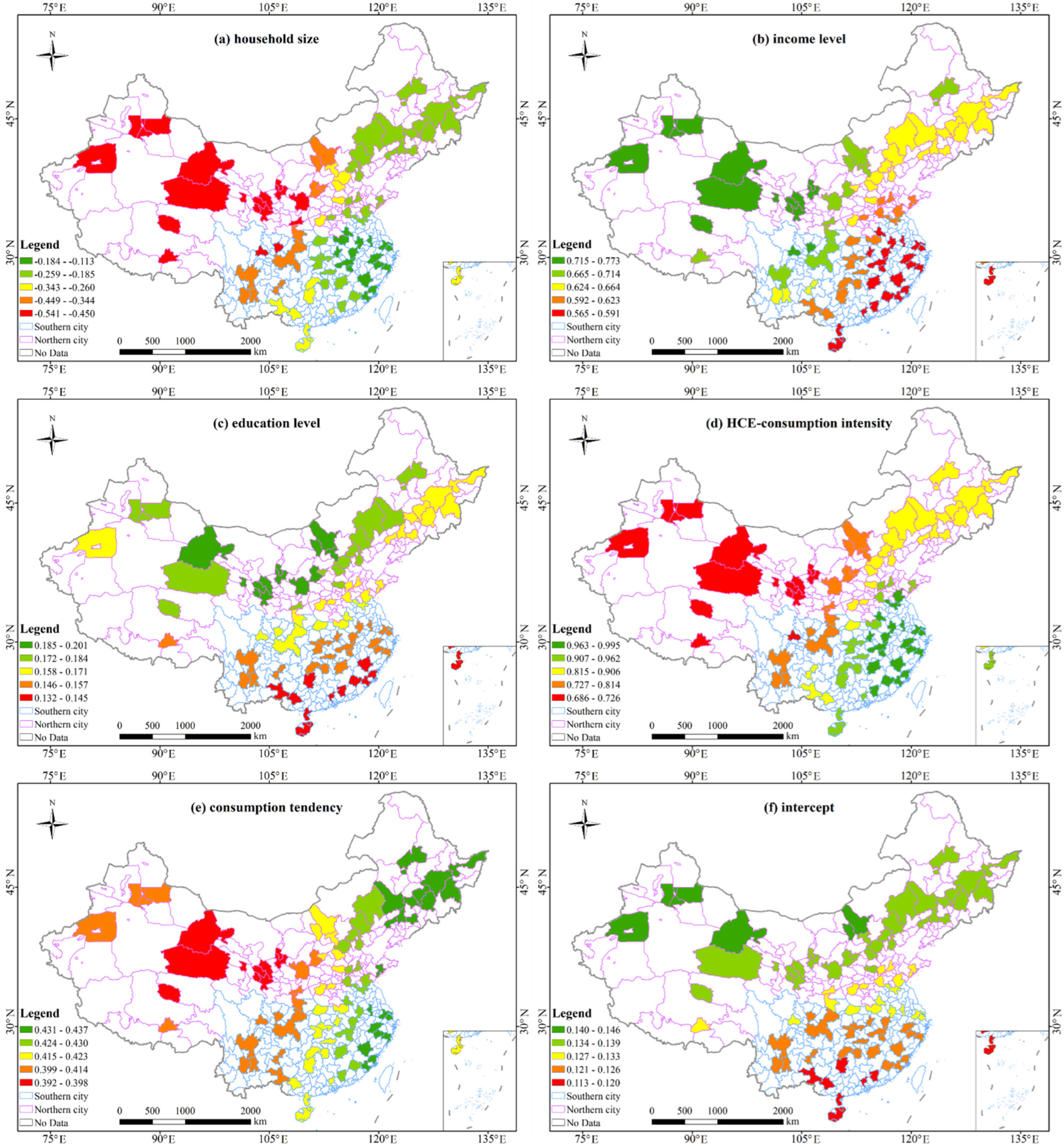City-Level Determinants of Household CO2 Emissions per Person: An Empirical Study Based on a Large Survey in China
Abstract
:1. Introduction
2. Materials and Methods
2.1. Data Survey
2.2. Estimation of PHCEs
2.3. The Multiscale Geographically Weighted Regression (MGWR)
3. Results
3.1. Overall Characteristics of PHCEs
3.2. Spatial Patterns in PHCEs
3.3. Results of the Multiscale Geographically Weighted Regression (MGWR)
4. Discussion and Conclusions
4.1. Discussion
4.2. Conclusions
Supplementary Materials
Author Contributions
Funding
Institutional Review Board Statement
Informed Consent Statement
Data Availability Statement
Acknowledgments
Conflicts of Interest
References
- Statement by H.E. Xi Jinping President of the People’s Republic of China at the General Debate of the 75th Session of the United Nations General Assembly. Available online: https://journal.un.org/en/meeting/officials/e6d6ab5e-c0de-ea11-9114-0050569e8b67/2020-09-22/statements (accessed on 22 September 2020).
- Ivanova, D.; Stadler, K.; Steen-Olsen, K.; Wood, R.; Vita, G.; Tukker, A.; Hertwich, E.G. Environmental impact assessment of household consumption. J. Ind. Ecol. 2016, 20, 526–536. [Google Scholar] [CrossRef]
- Shui, B.; Dowlatabadi, H. Consumer lifestyle approach to US energy use and the related CO2 emissions. Energy Policy 2005, 33, 197–208. [Google Scholar]
- Mi, Z.F.; Zheng, J.L.; Meng, J.; Qu, J.; Hubacek, K.; Liu, Z.; Coffman, D.M.; Stern, N.; Liang, S.; Wei, Y.M. Economic development and converging household carbon footprints in China. Nat. Sustain. 2020, 3, 529–537. [Google Scholar] [CrossRef]
- Liu, L.C.; Wu, G.; Wang, J.N.; Wei, Y.M. China’s carbon emissions from urban and rural households during 1992–2007. J. Clean. Prod. 2011, 19, 1754–1762. [Google Scholar] [CrossRef]
- Tian, X.; Chang, M.; Lin, C.; Tanikawa, H. China’s carbon footprint: A regional perspective on the effect of transitions in consumption and production patterns. Appl. Energy 2014, 123, 19–28. [Google Scholar] [CrossRef]
- Wiedenhofer, D.; Guan, D.B.; Liu, Z.; Meng, J.; Zhang, N.; Wei, Y.M. Unequal household carbon footprints in China. Nat. Clim. Chang. 2017, 7, 75–80. [Google Scholar] [CrossRef] [Green Version]
- Lin, B.B.; Jia, Z.J. Transfer payments in emission trading markets: A perspective of rural and urban residents in China. J. Clean. Prod. 2018, 204, 753–766. [Google Scholar] [CrossRef]
- Qu, J.S.; Liu, L.N.; Zeng, J.J.; Zhang, Z.Q.; Wang, J.P.; Pei, H.J.; Dong, L.P.; Liao, Q.; Maraseni, T.N. The impact of income on household CO2 emissions in China based on a large sample survey. Sci. Bull. 2019, 64, 351–353. [Google Scholar] [CrossRef] [Green Version]
- Liu, L.N.; Qu, J.S.; Zhang, Z.Q.; Zeng, J.J.; Wang, J.P.; Dong, L.P.; Pei, H.J.; Liao, Q. Assessment and determinants of per capita household CO2 emissions (PHCEs) based on capital city level in China. J. Geogr. Sci. 2018, 28, 1467–1484. [Google Scholar] [CrossRef] [Green Version]
- Liu, L.N.; Qu, J.S.; Maraseni, T.N.; Niu, Y.B.; Zeng, J.J.; Zhang, L.H.; Xu, L. Household CO2 emissions: Current status and future perspectives. Int. J. Environ. Res. Public Health 2020, 17, 7077. [Google Scholar] [CrossRef]
- Feng, K.S.; Davis, S.J.; Sun, L.X.; Hubacek, K. Drivers of the US CO2 emissions 1997–2013. Nat. Commun. 2015, 6, 7714. [Google Scholar] [CrossRef] [Green Version]
- C40 Cities. The Future of Urban Consumption in a 1.5 °C World. 2019. Available online: https://www.arup.com/perspectives/publications/research/section/the-future-of-urban-consumption-in-a-1-5c-world (accessed on 24 January 2022).
- Institute for Global Environmental Strategies (IGES). 1.5-Degree Lifestyles: Targets and Options for Reducing Lifestyle Carbon Footprints. 2019. Available online: https://pub.iges.or.jp/pub/15-degrees-lifestyles-2019 (accessed on 24 January 2022).
- Rao, N.D.; Min, J.; Mastrucci, A. Energy requirements for decent living in India, Brazil and South Africa. Nat. Energy 2019, 4, 1025–1031. [Google Scholar] [CrossRef]
- Maraseni, T.N.; Qu, J.S.; Bian, Y.; Zeng, J.J.; Maroulis, J. Dynamism of household carbon emissions (HCEs) from rural and urban regions of northern and southern China. Environ. Sci. Pollut. Res. Int. 2016, 23, 20553–20566. [Google Scholar] [CrossRef]
- Qu, J.S.; Zeng, J.J.; Li, Y.; Wang, Q.; Maraseni, T.N.; Zhang, L.H.; Zhang, Z.Q.; Clarke-Sather, A. Household carbon dioxide emissions from peasants and herdsmen in northwestern arid-alpine regions, China. Energy Policy 2013, 57, 133–140. [Google Scholar] [CrossRef]
- Liu, L.N.; Qu, J.S.; Clarke-Sather, A.; Maraseni, T.N.; Pang, J.X. Spatial variations and determinants of per capita household CO2 emissions (PHCEs) in China. Sustainability 2017, 9, 1277. [Google Scholar] [CrossRef] [Green Version]
- World Bank. 3 Big Ideas to Achieve Sustainable Cities and Communities. 2018. Available online: http://www.worldbank.org/en/news/immersive-story/2018/01/31/3-big-ideas-to-achieve-sustainable-cities-and-communities (accessed on 24 January 2022).
- Wang, S.J.; Shi, C.Y.; Fang, C.L.; Feng, K.S. Examining the spatial variations of determinants of energy-related CO2 emissions in China at the city level using Geographically Weighted Regression Model. Appl. Energy 2019, 235, 95–105. [Google Scholar] [CrossRef]
- Wang, S.J.; Wang, J.Y.; Fang, C.L.; Feng, K.S. Inequalities in carbon intensity in China: A multi-scalar and multi-mechanism analysis. Appl. Energy 2019, 254, 113720. [Google Scholar] [CrossRef]
- Cathy, C.W.H.; Shu-Chien, H.; Kuang-Ly, C. Quantifying city-scale carbon emissions of the construction sector based on multi-regional input-output analysis. Resour. Conserv. Recycl. 2019, 149, 75–85. [Google Scholar]
- The Chinese Government. Enhanced Actions on Climate Change: China’s Intended Nationally Determined Contributions. 2016. Available online: http://www.scio.gov.cn/xwfbh/xwbfbh/wqfbh/33978/35364/xgzc35370/Document/1514539/1514539.htm (accessed on 24 January 2022).
- Shan, Y.L.; Guan, D.B.; Hubacek, K.; Zheng, B.; Davis, S.J.; Jia, L.C.; Liu, J.H.; Fromer, N.; Mi, Z.F.; Meng, J.; et al. City-level climate change mitigation in China. Sci. Adv. 2018, 4, eaaq0390. [Google Scholar] [CrossRef] [Green Version]
- Cheng, S.L.; Chen, Y.T.; Meng, F.X.; Chen, J.D.; Liu, G.Y.; Song, M.L. Impacts of local public expenditure on CO2 emissions in Chinese cities: A spatial cluster decomposition analysis. Resour. Conserv. Recycl. 2021, 164, 105217. [Google Scholar] [CrossRef]
- Shan, Y.L.; Huang, Q.; Guan, D.B.; Hubacek, K. China CO2 emission accounts 2016–2017. Sci. Data 2018, 7, 54. [Google Scholar] [CrossRef] [PubMed] [Green Version]
- Le Quéré, C.; Korsbakken, J.I.; Wilson, C.; Tosun, J.; Andrew, R.; Andres, R.J.; Ganadell, J.G.; Jordan, A.; Peters, G.P.; Vuuren, D.P. Drivers of declining CO2 emissions in 18 developed economies. Nat. Clim. Chang. 2019, 9, 213–217. [Google Scholar] [CrossRef] [Green Version]
- Huang, Q.; Hu, Y.R.; Luo, L.Q. Spatial analysis of carbon dioxide emissions from producer services: An empirical analysis based on panel data from China. Environ. Sci. Pollut. Res. 2022. [Google Scholar] [CrossRef] [PubMed]
- Repkine, A.; Min, D. Foreign-funded enterprises and pollution halo hypothesis: A spatial econometric analysis of thirty Chinese regions. Sustainability 2020, 12, 5048. [Google Scholar] [CrossRef]
- Chuai, X.W.; Huang, X.J.; Wang, W.J.; Wen, J.Q.; Chen, Q.; Peng, J.W. Spatial econometric analysis of carbon emissions from energy consumption in China. J. Geogr. Sci. 2012, 22, 630–642. [Google Scholar] [CrossRef]
- Qu, J.S.; Qin, S.S.; Liu, L.N.; Zeng, J.J.; Bian, Y. A hybrid study of multiple contributors to per capita household CO2 emissions (HCEs) in China. Environ. Sci. Pollut. Res. 2016, 23, 6430–6442. [Google Scholar] [CrossRef] [Green Version]
- Fotheringham, A.S.; Yang, W.; Kang, W. Multiscale Geographically Weighted Regression (MGWR). Ann. Am. Assoc. Geogr. 2017, 107, 1247–1265. [Google Scholar] [CrossRef]
- Oshan, T.M.; Li, Z.Q.; Kang, W.; Wolf, L.J.; Fotherigham, A.S. MGWR: A Python implementation of multiscale geographically weighted regression for investigating process spatial heterogeneity and scale. ISPRS Int. J. Geo–Inf. 2019, 8, 269. [Google Scholar] [CrossRef] [Green Version]
- Shabrina, Z.; Buyuklieva, B.; Ng, M.K.M. Short-term rental platform in the urban tourism context: A geographically weighted regression (GWR) and a multiscale GWR (MGWR) approaches. Geogr. Anal. 2020, 53, 686–707. [Google Scholar] [CrossRef]
- Yu, H.C.; Fotheringham, A.S.; Li, Z.Q.; Oshan, T.; Kang, W.; Wolf, L.J. Inference in Multiscale Geographically Weighted Regression. Geogr. Anal. 2020, 52, 87–106. [Google Scholar] [CrossRef]
- Intergovernmental Panel on Climate Change, IPCC. IPCC Guidelines for National Greenhouse Gas Inventories. 2006. Available online: http://www.ipcc-nggip.iges.or.jp/publi,c/2006gl/ (accessed on 24 January 2022).
- Li, C.; Ye, K.; Zhang, W.T.; Xu, Y.H.; Xu, J.D.; Li, J.; Mawusi, S.K.; Shrestha, P.; Xue, C.Y.; Liu, G.G. User behavior, influence factors, and impacts on real-world pollutant emissions from the household heating stoves in rural China. Sci. Total Environ. 2022, 823, 153718. [Google Scholar] [CrossRef]
- Chen, Y.L.; Shen, H.Z.; Smith, K.R.; Guan, D.B.; Chen, Y.C.; Shen, G.F.; Liu, J.F.; Cheng, H.F.; Zeng, E.Y.; Tao, S. Estimating household air pollution exposures and health impacts from space heating in rural China. Environ. Int. 2018, 119, 117–124. [Google Scholar] [CrossRef] [Green Version]
- Chen, C.C.; Liu, G.Y.; Meng, F.X.; Hao, Y.; Zhang, Y.; Casazza, M. Energy consumption and carbon footprint accounting of urban and rural residents in Beijing through Consumer Lifestyle Approach. Ecol. Indic. 2019, 98, 575–586. [Google Scholar] [CrossRef]
- Meng, F.X.; Liu, G.Y.; Yang, Z.F.; Casazza, M.; Cui, S.H.; Ulgiati, S. Energy efficiency of urban transportation system in Xiamen, China. Appl. Energy 2017, 186, 234–248. [Google Scholar] [CrossRef]
- Han, L.Y.; Xu, X.K.; Han, L. Applying quantile regression and Shapley decomposition to analyzing the determinants of household embedded carbon emissions: Evidence from urban China. J. Clean. Prod. 2015, 103, 219–230. [Google Scholar] [CrossRef]






| Basic Information | Research Category | Number |
|---|---|---|
| Applicant information | Occupation, Education, Gender, Age | 4 |
| Household basic information | Home address, Nation, Household size, Household structure, Household income, Sources of income | 6 |
| Direct household energy usage | Anthracite, Bituminous, Honeycomb, Gasoline form motor, Gasoline form car, Diesel, Kerosene, LPG, Coal Gas, Nature Gas | 10 |
| Indirect household consumption | Water, Electricity, Heating, Food, Clothing, Commodity, Health, Education, Recreation, Transportation, Communication | 11 |
| Variables | Implication | Unit |
|---|---|---|
| PHCEs | Household CO2 emissions per person | t CO2/person |
| household size | Total population per household | person |
| income level | Income per person | 104 RMB/person |
| education level | The proportion of population with high school education and above | % |
| HCEs intensity | Similar to the carbon emission intensity, represents the intensity of HCEs | t CO2/104 RMB |
| consumption tendency | The ratio of consumption to income | % |
Publisher’s Note: MDPI stays neutral with regard to jurisdictional claims in published maps and institutional affiliations. |
© 2022 by the authors. Licensee MDPI, Basel, Switzerland. This article is an open access article distributed under the terms and conditions of the Creative Commons Attribution (CC BY) license (https://creativecommons.org/licenses/by/4.0/).
Share and Cite
Qu, J.; Liu, L.; Zeng, J.; Maraseni, T.N.; Zhang, Z. City-Level Determinants of Household CO2 Emissions per Person: An Empirical Study Based on a Large Survey in China. Land 2022, 11, 925. https://doi.org/10.3390/land11060925
Qu J, Liu L, Zeng J, Maraseni TN, Zhang Z. City-Level Determinants of Household CO2 Emissions per Person: An Empirical Study Based on a Large Survey in China. Land. 2022; 11(6):925. https://doi.org/10.3390/land11060925
Chicago/Turabian StyleQu, Jiansheng, Lina Liu, Jingjing Zeng, Tek Narayan Maraseni, and Zhiqiang Zhang. 2022. "City-Level Determinants of Household CO2 Emissions per Person: An Empirical Study Based on a Large Survey in China" Land 11, no. 6: 925. https://doi.org/10.3390/land11060925
APA StyleQu, J., Liu, L., Zeng, J., Maraseni, T. N., & Zhang, Z. (2022). City-Level Determinants of Household CO2 Emissions per Person: An Empirical Study Based on a Large Survey in China. Land, 11(6), 925. https://doi.org/10.3390/land11060925









